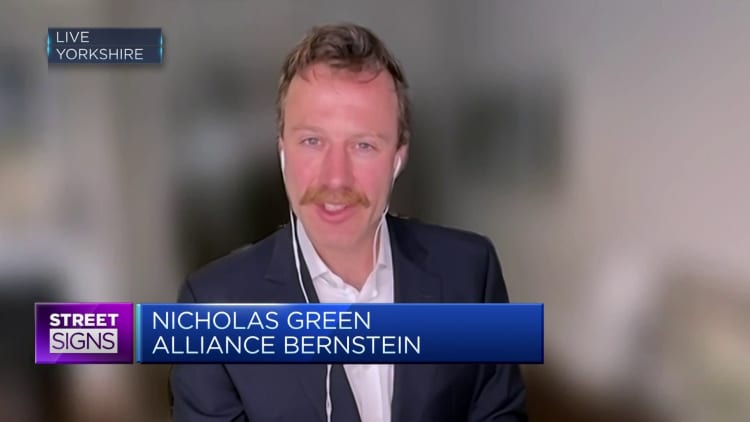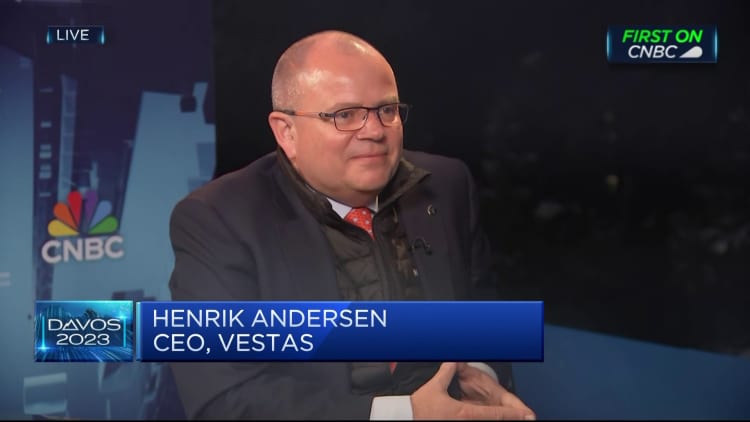A Siemens Gamesa blade factory on the banks of the River Humber in Hull, England on October 11, 2021.
PAUL ELLIS | AFP | Getty Images
Costly failures at wind turbine manufacturer Siemens Gamesa last month sent shares of parent company Siemens Energy tumbling, and analysts are concerned about wider teething problems across the industry.
The German energy giant scrapped its profit guidance in late June, citing a “substantial increase in failure rates of wind turbine components” at its wind division Siemens Gamesa.
Siemens Energy CEO Christian Bruch told journalists on a call Friday that “too much had been swept under the carpet” at Siemens Gamesa and that the quality issues were “more severe than [he] thought possible.”
Siemens Energy stock plunged by around 37% on June 23, while other wind companies also saw shares retreat as investors worried that the problems at Gamesa might be a symptom of a wider issue for the industry.
Nicholas Green, head of EU capital goods and industrial technology at AllianceBernstein, told CNBC that the pace of expansion, and the fact that many components of larger turbines haven’t actually been in use for very long, means there could be inherent risks throughout the sector.
“We have to acknowledge that putting brand new machinery — whether it’s on-shore or even more difficult off-shore wind farms — and the pace of change in that machinery has put us into slightly uncharted territory,” he said.
“Although it’s hard to tell at the moment, my best guess is that this probably actually is an industry-wide issue. It wasn’t that Siemens Gamesa is a bad operator as such, it’s that actually some of the normal protocols and time in use, operational data in use, is relatively limited.”
Siemens Gamesa’s board is now due to conduct an “extended technical review” into the issue, which is expected to incur costs in excess of 1 billion euros ($1.09 billion). The company’s shares have recouped some losses, but remain down over 33% in the last month.
A tough two years
The wind industry has expanded rapidly over the past two decades, lowering costs to rival — and sometimes undercut — those of fossil fuels, while boosting efficiency with ever-bigger turbines and reducing reliance on state subsidies.
“These cost reductions have been achieved with innovations in turbine technology and by pushing the boundaries of engineering,” Christoph Zipf, spokesman for industry body WindEurope, told CNBC via email.
He said that 20 years ago, a typical wind turbine would have 1 million watts of capacity; today, European original equipment manufacturers, or OEMs, are testing 15 MW turbines.
“This means that turbines have become bigger as well, posing challenges to components (quality, materials, longevity). The introduction of competitive auctions has also been a driving factor in this cost reduction,” Zipf added.
The Statistical Review of World Energy report published last week revealed that wind and solar power accounted for 12% of the world’s power generation last year, with wind power output increasing by 13.5%.

The industry was hit hard by the Covid-19 pandemic, as resulting lockdowns depressed industrial activity and reduced global energy demand. The ensuing supply chain problems then hampered OEMs.
These manufacturers have since endured a further shock from soaring inflation and input costs as Russia’s invasion of Ukraine disrupted markets and aggravated supply chain disruptions. WindEurope estimates that the rise in commodity prices has increased the price of wind turbines by up to 40% over the last two years.
“OEMs were sourcing some material from Russia (mostly nickel) and Ukraine (mostly steel). The price of both skyrocketed after the invasion. This comes on top of the challenging inflationary environment all European businesses are operating in (i.e. rising electricity prices, etc.),” Zipf explained.
“A main problem for the OEMs is that not all countries had indexed their renewables auctions. Consequently wind turbine orders were not necessarily indexed to inflation. The time between the order intake and the commissioning of a wind turbine can take up to 18 months (especially when supply of materials is short).”

However, Zipf denied that industry-wide technical failures could be on the horizon, insisting that “the problems at Siemens Gamesa are limited to Siemens Gamesa.”
“Big turbine failures are extremely rare given the number of turbines installed in Europe already. However, the competition in the sector is pushing OEMs to come up with bigger and better turbines at a fast rate, may be faster than in other sectors,” he said.
He also challenged the notion that the industry has entered “uncharted territory,” arguing that the changes in turbine technology have been “incremental and evolutionary.”
“Naturally every new turbine model comes with new challenges, requires rigorous testing and certification. But the European wind industry has overcome all of these challenges and maintained its reputation for delivering highly reliable high-quality turbines,” Zipf said.
Facts and figures
According to ONYX Insight, which monitors wind turbines and tracks over 14,000 across 30 countries, most turbines are designed and certified for 20 years but contain components that will fail during that time due to a “compromise between the cost of the system and reliability.”
“We have been aware for some time that turbine failure rates across the industry can — and should — be more widely understood, given the scale of their potential impact on the overall profitability of projects,” Evgenia Golysheva, vice president of strategy and marketing at ONYX, told CNBC.
“It’s not that they are made badly, but we now have a compromise between the cost of energy and targeted reliability. Everyone who builds, finances and operates wind turbines needs to have a realistic picture of how many failures to expect.”
In turbines built in 2023, more than 40% of gearboxes will need to be replaced after 20 years of project life, according to ONYX, along with over 20% of main bearings and more than 5% of blades.

Across the wind industry, around 65% of operations and maintenance costs are unplanned, according to ONYX. It projects that major corrective spending will rise to $4 billion by 2029.
“The growth of wind installations has been unprecedented, and the industry has had to scale up very quickly with little time to digest it. It’s not a capacity issue, and it’s not new, but it is good that OEMS (who are under pressure from supply chain and from inflation) are bringing this conversation into the public domain,” Golysheva explained.
“It’s a conversation that is overdue, because the underlying issues aren’t going away. For example, wind turbine rotors are getting bigger, the turbines are getting bigger, and the development cycles are short, so it’s crucial to have digital and other diagnostic tools to be able to deal with reliability issues.”


